

SOUTH DAKOTA COOPERATIVES
How Co-ops Have Impacted the State Pages 8-9
Ghost Towns Pages 12-13



How Co-ops Have Impacted the State Pages 8-9
Ghost Towns Pages 12-13
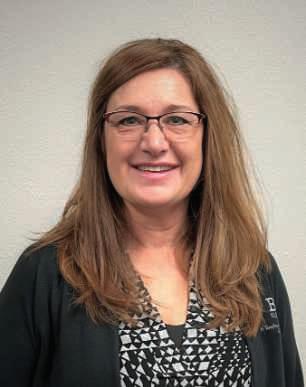
Stephanie Horst horst@byelectric.com
Communities come in all shapes and sizes. Some are based on geographical proximity, some are based on shared interests or hobbies, and some communities can even be found in virtual spaces like social media groups. Regardless of where or how they are formed, communities can bring people together and create a sense of belonging.
B-Y Electric is deeply committed to our members, and we’re glad you are part of the electric cooperative community.
In October, more than 30,000 cooperatives across the U.S. are celebrating National Co-op Month. It’s a time to reflect on all the aspects that set cooperatives apart from other types of businesses, but more importantly, it’s a time to celebrate the power of co-op membership.
Electric cooperatives are not-for-profit utilities that are built by the communities they serve. For B-Y Electric, our mission has always been to provide you with reliable power. We care about your quality of life, and because we are locally operated, we’re uniquely suited to meet our members’ evolving energy needs.
Beyond the business of electricity, our employees and directors are equally invested in our local community. Why? Because we live here, too. That’s why we work hard to support local economic development projects, youth programs and scholarships, charitable giving initiatives and additional programs that make our community a better place to call home.
All co-ops, including B-Y Electric, are guided by seven cooperative principles that embody the values and spirit of the cooperative movement. These seven principles are a framework to help all co-ops navigate challenges and opportunities while remaining true to our purpose:
1. Open and Voluntary Membership: Co-op membership is open to anyone who can use the co-op’s services.
2. Democratic Member Control: Members make decisions that shape the cooperative. Why? Because co-ops are created by the members, for the members.
A special thank you goes out to the members that participated in our annual meeting on August 20th.You will find more information about the annual meeting later in this issue.
3. Members’ Economic Participation : Members contribute money to the co-op to make sure it runs smoothly now and in the future. At B-Y Electric, this happens through paying your energy bills.
4. Autonomy and Independence: Co-ops are independent and can operate on their own, which ultimately benefits the members.
5. Education, Training and Information: Co-ops continuously focus on education to ensure employees have the training and information they need to make the co-op successful.
6. Cooperation Among Cooperatives: Co-ops share with and learn from other cooperatives. We help each other out in times of need because we want other co-ops to thrive.
7. Concern for Community: All cooperatives work for the greater good of the local communities they serve. Co-ops give back to their communities to help them thrive and grow.
This October, as we celebrate National Co-op Month and the power of membership, we hope you will recognize the many aspects that set electric cooperatives apart.
As of this article submission, we do not have rate information from our power suppliers. Once we have this information, we will complete our budgeting processes that determine if a rate adjustment is needed and how much. It is our intent to let our members know as soon as possible.
(USPS No. 018-973)
Bon Homme Yankton Electric Association, Inc PO Box 158 134 S. Lidice St. Tabor, SD 57063
Office Hours: Monday through Friday 7:30am - 4:00pm
To pay by phone, call: 1-888-395-5315
The August board meeting was held on August 21, 2024 at 8:05 am. Directors present were Dave Sternhagen, Dave Sykora, Dean Sternhagen, Rick Cheloha, Brian Brandt, Robert Ruppelt and Paul Voigt. Others present were the attorney, management staff and guest employee.
THE BOARD APPROVED THE CONSENT AGENDA:
• July 2024 Board Meeting minutes
• Four Capital Credits to Estates Discounted - $13,308.68
documentation. The board authorized the signing and submission of the loan application in the amount of $8,486,000.
• 2024 Co-Bank Mail in Ballot - board authorized Horst to vote and file ballot
To report an outage, call: Local call from Tabor, Tyndall, and Yankton: 605-463-2507
To report an outage, call: Local call from Tabor, Tyndall, and Yankton: 605-463-2507
NOTICE: Electric bills must be paid by 10:00am on the 20th of each month to avoid a $10 late fee.
NOTICE: Electric bills must be paid by 10:00am on the 20th of each month to avoid a $10 late fee.
Board President: Paul Voigt
Board of Directors
President: Dean Sternhagen Board of Directors
Dave Sykora - Vice President
Dave Sternhagen - Secretary
Sykora - Vice President
Robert Ruppelt - Treasurer
Dave Sternhagen - Secretary
Dean Sternhagen
Robert Ruppelt - Treasurer
John Lillevold
Paul Voigt
Rick Cheloha
Brian Brandt Rick Cheloha
General Manager: Stephanie Horst Operations Manager: Ken Carda
General Manager: Stephanie Horst
Office Manager: Nicole Einrem
Operations Manager: Ken Carda
Office Manager: Nicole Einrem
Editor: Chantelle Jungemann
• Review New Members & Cancellations
• Closed Work Order Inventory - #913 for $108,027.34
• Review Special Equipment Purchases$14,783.43 (transformer) THE BOARD REVIEWED AND ACCEPTED FOLLOWING REPORTS:
• Member Service Report
• Operations & Safety Report
• Office & Financial Reports
• General Manager Report
• East River Cyber Security/IT Report
• SDREA Report
• East River Report
Members Service Advisor: Aaron Melichar
Members Service Advisor: Aaron Melichar Editor: Chantelle Jungemann
Bon Homme Yankton Electric Cooperative Connections is the monthly publication for the members of Bon Homme Yankton Electric Association, Inc, PO Box 158, 134 S. Lidice St., Tabor, SD 57063-0158. Families subscribe to Cooperative Connections as part of their electric cooperative membership. The purpose of Bon Homme Yankton Electric Cooperative Connections is to provide reliable, helpful information to electric cooperative members on electric cooperative matters and better rural living. Subscription information: Cooperative members devote 50 cents from their monthly electric payments for a subscription. Non-member subscriptions are available for $12 annually. Periodicals postage paid at Tabor, SD 57063.
Bon Homme Yankton Electric Cooperative Connections is the monthly publication for the members of Bon Homme Yankton Electric Association, Inc, PO Box 158, 134 S. Lidice St., Tabor, SD 57063-0158. Families subscribe to Cooperative Connections as part of their electric cooperative membership. The purpose of Bon Homme Yankton Electric Cooperative Connections is to provide reliable, helpful information to electric cooperative members on electric cooperative matters and better rural living. Subscription information: Cooperative members devote 50 cents from their monthly electric payments for a subscription. Non-member subscriptions are available for $12 annually. Periodicals postage paid at Tabor, SD 57063.
Postmaster: Please send address changes to Bon Homme Yankton Electric Cooperative Connections, PO Box 158, Tabor, SD 57063; telephone (605) 463-2507. UPDATED Pay by Phone, call: 1-855-941-3507
Postmaster: Please send address changes to Bon Homme Yankton Electric Cooperative Connections, PO Box 158, Tabor, SD 57063; telephone (605) 463-2507. This institution is an equal opportunity provider and employer.

• Basin Annual Meeting Report OTHER GOVERNANCE
• RUS Construction Funds Loan - Tom Jones, RUS Field Representative, reviewed the loan request, financial forecast and the required
• Board Acknowledged East River Annual Meeting Notice, September 4, 2024
• Board Acknowledged CFC District 6 Meeting Notice, September 17, 2024
• Appointed CFC Voting Delegate/ Alternate (Voigt/Dean Sternhagen)
• Cooperative Family Fund - discussed participation, tabled for now
• Operation Roundup® Committee Member Designation - Casey Kruse for District 3 and Beth Mikkelsen for District 5
• Operation Roundup® Board Designation - Dean Sternhagen to serve as Board representative and chair of Operation Roundup® Committee
• Enter/Exit Executive Session
• Next Meeting date set for Friday, September 13, 2024, at 8:00 am.
Cooking and heating are the leading causes of home fires and fire injuries, and winter months are the peak time for fire-related deaths. Fire Prevention Week (Oct. 6-12, 2024) is the perfect time to review and practice fire safety.
The good news: Deaths from home fires in the U.S. have trended downward since the 1970s, according to Injury Facts, but even one death from a preventable fire is too many. While fire doesn’t discriminate by age, it is the third leading cause of death for children 1 to 14.
When cooking, make fire safety a priority by keeping these tips in mind:
• Be alert; if you are sleepy or have consumed alcohol, don’t use the oven or stovetop.
• Stay in the kitchen while you are frying, grilling, boiling or broiling food.
• Keep anything that can catch fire away from your stovetop.
Heating is the second leading cause of home fires. Follow these tips:
• Keep all flammables, like paper, clothing, bedding, drapes or rugs, at least three feet from a space heater, stove or fireplace.
• Never leave portable heaters and fireplaces unattended; turn off heaters and make sure fireplace embers are extinguished before leaving the room.
• If you must use a space heater, place it on a level, nonflammable surface, like ceramic tile, not on a rug or carpet.
• Keep children and pets away from space heaters.
• When buying a space heater, look for models that shut off automatically if the heater falls over.
About three out of five fire deaths happen in homes without working smoke alarms. Smoke alarms are a key part of a home fire escape plan providing early warning to reduce your risk of dying in a fire. The National Fire Protection Association recommends you:
• Install smoke alarms on every level of your home, inside bedrooms and outside sleeping areas on the ceiling or high on the wall.
• Keep smoke alarms away from the kitchen, at least 10 feet from the stove, to reduce false alarms.
• Use special alarms with strobe lights and bed shakers for
people who are hard of hearing or deaf.
• Test smoke alarms monthly.
• Replace batteries in your smoke alarm and carbon monoxide detector annually.
• Replace smoke alarms that are 10 or more years old.
Always put your safety first; if you are not confident in your ability to use a fire extinguisher, get out and call 9-1-1. The American Red Cross cautions you to evaluate the situation and ensure:
• Everyone has left or is leaving the home
• The fire department has been called
• The fire is small, not spreading, and there is not much smoke
• Your back is to an exit you can use quickly
Remember the acronym PASS:
Pull the pin.
Aim low at the base of the fire.
Squeeze the handle slowly.
Sweep the nozzle side to side.
Source: National Safety Council

“Watch Out for Power Lines!”
Archer Rindels warns readers to be careful around power lines. Thank you for your picture, Archer! Archer’s parents are Kyle and Rochelle Rindels, members of Sioux Valley Energy.
Kids, send your drawing with an electrical safety tip to your local electric cooperative (address found on Page 3). If your poster is published, you’ll receive a prize. All entries must include your name, age, mailing address and the names of your parents. Colored drawings are encouraged.
SOUP

CHEESY CHICKEN BUNDLES
Ingredients:
1 (11 oz.) can condensed cream of chicken soup
1/2 cup milk
3/4 cup Velveeta, shredded or cubed
1 (10 oz.) can chunk chicken, drained and flaked
1 (8 oz.) can crescent rolls
Method
Combine soup, milk and cheese. Heat until melted and smooth. Pour into a 7x11 inch pan that has been sprayed with vegetable oil.
Separate crescents into 8 triangles. Place 2 tbsps. of chicken on wide end of crescent roll. Pinch to seal. Place on top of sauce.
Bake uncovered at 375 degrees for 25 minutes and until golden brown. Serve with sauce on top.
Yields eight chicken bundles or four servings.
Janet Ochsner
Box Elder, S.D.
Ingredients:
3 boneless chicken breasts
1 tbsp. minced garlic
1 can crushed tomatoes (28 oz. can)
1 can tomato sauce (15 oz. can)
1 tsp. salt
1 tsp. ground black pepper
2 tsp. Italian seasoning
4 cups chicken broth
1 cup parmesan cheese (freshly shaved)
1 cup heavy whipping cream
8 oz. rotini pasta (uncooked)
1 1/2 cup shredded Mozzarella
Method
Add the chicken breast, minced garlic, crushed tomatoes, tomato sauce, salt, pepper, Italian seasoning and chicken broth to the Crock-Pot.
Cover Crock-Pot with lid and cook on low for 6-8 hours.
Shred the chicken. Stir in the shredded parmesan cheese, heavy whipping cream and rotini pasta. Cover and cook on low for 30 minutes.
Top the individual soup servings with mozzarella cheese.
Kayla Beaner Centerville, S.D.
Ingredients:
4 tsps. Garam Masala blend
1/2 tsp. garlic powder
1/2 tsp. ground ginger
1/2 tsp. ground turmeric
1/8 tsp. crushed red pepper
4 tbsps. butter, divided
1 can (14.5 oz.) petite diced tomatoes
1 med. red onion, chopped
1 1/4 lbs. boneless skinless chicken breasts, cut into 1-inch cubes
1/4 cup heavy cream
1/2 tsp. sea salt
Method
Mix Garam Masala, garlic, ginger, turmeric and crushed red pepper in small bowl. Heat large non-stick skillet on medium heat. Toast seasoning mixture 1 min. or just until fragrant, stirring constantly. Add 2 tbsps. of the butter to skillet, swirling to melt. Add onion; cook and stir 2 to 3 mins. until softened. Stir in tomatoes; cook 5 mins. Carefully transfer mixture to blender container; cover. Blend until smooth, scraping sides as needed. Return pureed sauce to skillet. Bring to simmer on med.low heat. Add chicken; cook 8 to 10 minutes or until chicken is cooked though, stirring occasionally. Stir in remaining butter, cream and salt until well blended. Simmer on med.-low heat 2 to 3 minutes until sauce is slightly thickened. Stir in additional crushed red pepper to taste and serve with hot cooked basmati rice or warm naan bread, if desired. Garnish with fresh cilantro leaves, if desired.
McCormick.com
Please send your favorite recipes to your local electric cooperative (address found on Page 3). Each recipe printed will be entered into a drawing for a prize in December 2024. All entries must include your name, mailing address, phone number and cooperative name.
Can your house run on a 5kW solar system?
July 2024 Office Solar Production
Monthly KWH Produced ........................ 784
Average Daily KWH ................................. 25
June 2024 Office Solar Production
Monthly KWH Produced ....................... 731
Average Daily KWH ............................... 24
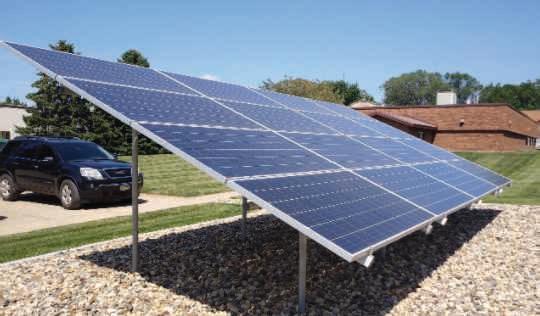
Bon Homme Yankton Electric was excited to participate in the 41st Anniversary of Yankton Riverboat Days. Riverboat Days was held August 16th, 17th, and 18th with the grand parade Saturday morning, arts festival all days, food trucks, live music, dancing, and for the first time a drone show Saturday night.
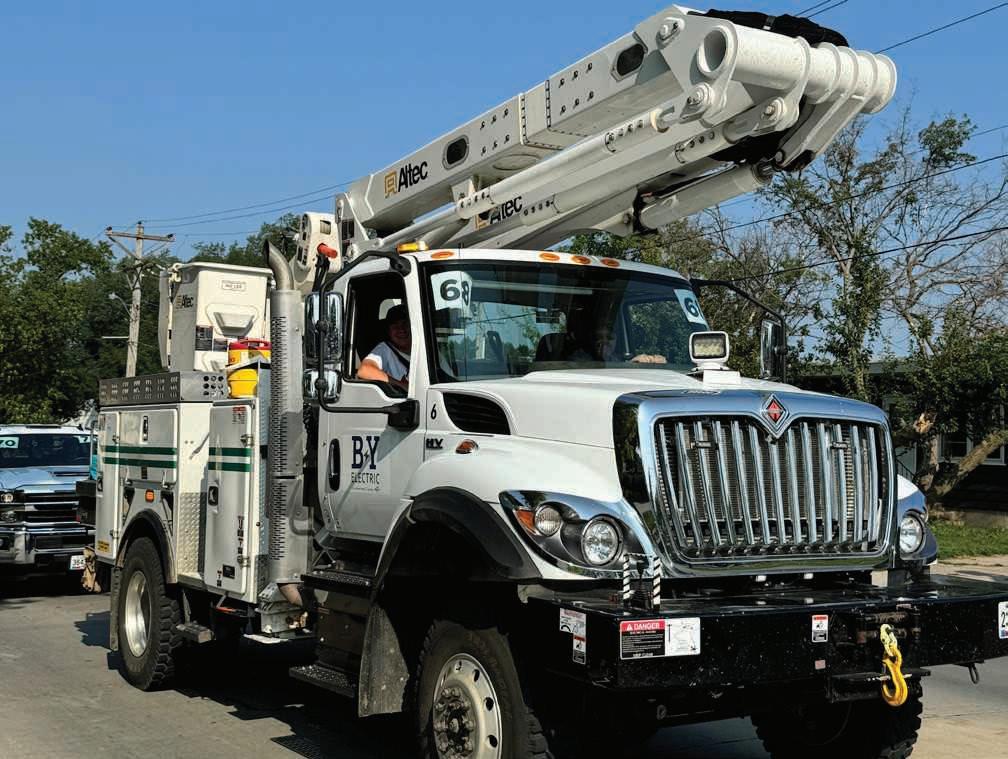
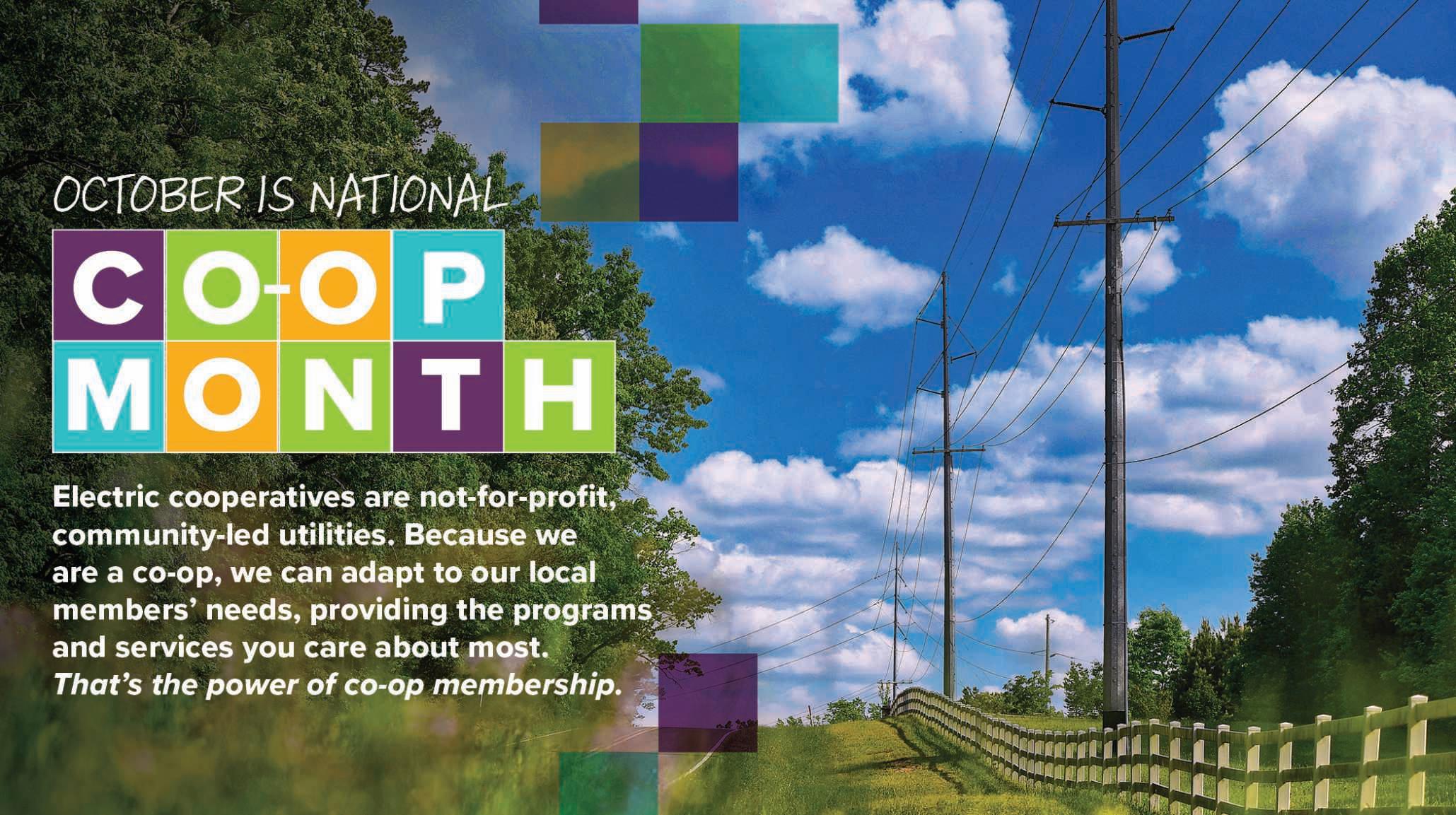
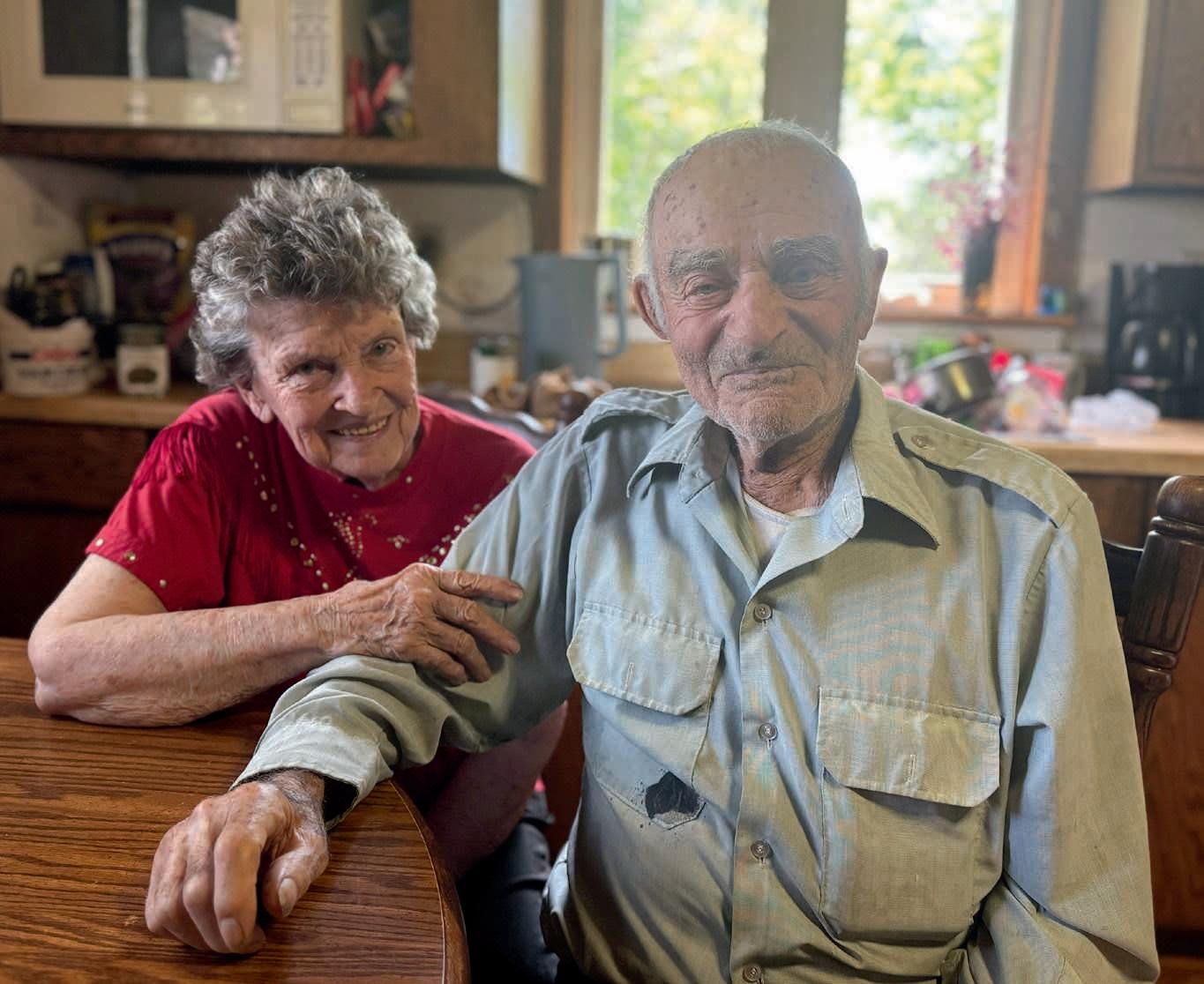
JJ Martin and Shannon Marvel
For the last 66 years, Herman Rosenau has been thankful he hasn’t had to pump water for the cows by hand at his farm and ranch near Glad Valley.
In 1957, Rosenau became one of the first members of Moreau-Grand Electric Cooperative in Timber Lake, S.D.
Coming of age at the tail end of World War II, Rosenau bore witness to some major world changes. As rural South Dakota started electrifying, Europe and East Asia were in turmoil. Before shipping off for the war, Rosenau’s life was all manual labor. After seeing the metamorphosis that the other half of the world went through, Rosenau watched his own world drastically change. Electricity slowly spread out across the Moreau-Grand service area like lightning in slow motion.
With a mischievous smile, Rosenau
sat down at the kitchen table with his morning coffee to discuss how he remembered the lights coming on at his home. After haying all morning, he was happy for a break.
“Things changed not all overnight, but pretty steady,” Rosenau said. “We got an electric refrigerator, then we got electricity out of a pump jack on the well. Everything kept growing little by little.”
Before electricity, Rosenau recalls watering the cows with a windmill in the water tank.
“And when the wind didn’t blow, you pumped the water by hand,” Rosenau said.
He remembers when the first electric bills totaled around $7 per month.
“Well, story of my life was a pitchfork and a team of horses until around 1947,” he said with a laugh.
With electricity becoming available
to rural folks in South Dakota, Rosenau recalled being able to purchase a deep freeze. That electric appliance allowed him to store food, particularly beef, for long periods of time and saved him the 70-mile round-trip to Lemmon to the meat locker.
Rosenau is not one to forget how thankful he is for having access to electricity and freedom. The electricity reached his home a few years after he returned home from serving in the Army. The World War II veteran said he went in at the time of the Belgian Bulge.
“I went to the Texas Infantry in the spring when it looked like the war in Europe was getting under control,” Rosenau said.
“I was in Manila when they dropped them two little eggs on Japan. And if they hadn’t done that, I don’t think I’d be here. Because they told us if we have to go ashore in Japan, we will lose a half million to a million boys going ashore. That’s the total population of South Dakota.”

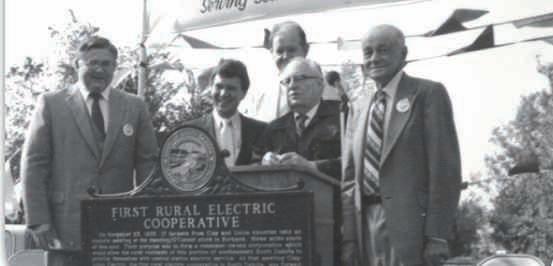
Jacob Boyko jacob.boyko@sdrea.coop
Picture life in rural South Dakota 100 years ago. Each morning, families woke before dawn to work by the flicker of kerosene lamps, hand-pumped water to fill a gas-powered wringer-washer, and retrieved breakfast ingredients from a dripping ice box. Looming in the backs of producers’ minds were fears that the market would trend downward and they may not be able to cover their debts, or even harvest their fields.
Today, South Dakota’s rural farmers and ranchers enjoy virtually all of the accommodations of modern living their suburban counterparts enjoy. Past luxuries like running water, full-time electricity, internet and telephone are now standard, and many farmers enjoy stronger economic security compared to the past’s tumultuous markets.
That’s because for over 100 years, rural South Dakotans have pooled their resources by forming cooperatives that level out some of the disparities between rural and urban life. Thanks to members’ ingenuity, rural America is not just a viable, but a thriving place to live and work.
The first cooperatives in South Dakota were agriculture-focused. Far too often, an
oversupply of goods led to price crashes, resulting in farmers unable to economically harvest crops or market livestock. This led to tremendous waste and crushed livelihoods.
As producers grew weary of the uncertain market, they organized to collectively market and distribute their products: they coordinated, shared risk and pooled resources.
South Dakota’s earliest farm supply and marketing cooperatives started popping up a little after the turn of the 20th century. The South Dakota Secretary of State’s office lists Lake Andes Farmers Cooperative, formed in 1909, as the oldest ongoing cooperative in the state.
During this early period, cooperatives operated in a legal gray area. Since producers working collectively in a cooperative setting could be viewed as monopolistic or collusive, they were under careful watch by the Federal Trade Commission as well as their larger competitors.
That changed in 1922 with the passage of the Capper-Volstead Act.
“Capper-Volstead allowed producers to come together and market their products and not be in violation of the Sherman Antitrust Act,” explained Brenda Forman, South Dakota Association of Cooperatives executive director. “[Cooperatives] were not considered to be a monopoly as long as they were a cooperative association formed
Clay-Union Electric Corporation was the first electric cooperative in South Dakota.
by producers, owned by the members, one member gets one vote in cooperative elections, etc.”
The presence of ag cooperatives surged in the 1930s as producers looked for stability during the Great Depression, the South Dakota Farmers Union says. With effectiveness proven, the cooperative strategy has stuck around since.
Today, there are 63 farm supply and marketing cooperatives serving over 130 South Dakota communities, Forman said.
Those same visionaries who established the first ag cooperatives identified another need that was not being met. Using the same cooperative model that changed their lives once already, farmers would bring power to the prairie.
Before energy infrastructure was widespread, many small towns in South Dakota relied on local power plants. However, with distribution lines only serving the city, living even a mile or two out of town was the difference between flipping a light switch and carrying a lantern. Despite requests from farmers to run lines to their homes – some of whom even offered to pay installation costs – most municipalities and investor-owned utilities (IOUs) refused because undertaking the effort didn’t lead to any meaningful profit. Even many of the state’s elected representatives seemed resigned to the idea
that the future of energy for their farming constituents was tied to on-site generation, like the modest Delco–Light plants that could power a few small appliances and light bulbs. To them, it seemed laughable that there was any feasible way to run lines in a state where the service would average out to a sparse 2.2 customers per mile of line, and for many, that was the end of the conversation.
The narrative changed when President Franklin D. Roosevelt expanded his New Deal programs to modernize rural America, creating the Rural Electrification Administration (REA) to finance ambitious projects.
The profit-minded IOUs were largely uninterested in expanding into sparse territory for measly returns, and little progress was made toward Roosevelt’s vision.
In 1936, once it was apparent IOUs wouldn’t be making the foray into rural territories as farmers had hoped they would, Roosevelt signed the Rural Electrification Act. Now, cooperatives could organize and receive REA loans while the IOUs idled.
A group of 17 farmers from Clay and Union counties jumped at the opportunity to finally bring their homes into the modern age. Just months after the REA was established, and at a time when just 5% of South Dakota farms had power, the group hatched out a plan to secure an REA loan for their newly-formed Fairview Rural Electric System, today Clay-Union Electric Corporation.
Going door to door and collecting $5 sign-ons from neighbors ranging from ecstatic to skeptical, the cooperative finally got the REA’s green light and received a $70,000 loan to build 67 miles of line that would serve about 300 members, according to a 1936 Argus Leader report.
The success of South Dakota’s first electric cooperative brought hope to still more than 90% of South Dakota farmers without power. It wasn’t long before dozens more newly-formed cooperatives were each going door to door collecting sign-on fees to secure their own REA loans.
In 1946, roughly 10 years after the state’s first electric cooperative debuted, rural farmers and ranchers from the state’s
remote northwest corner met in Lemmon to form their own cooperative. The board understood securing a loan from REA to serve such a vast and sparse territory would be a big ask, so they opted to charge members a $10 monthly minimum, which was twice the minimum rate of most South Dakota cooperatives, and equal to about $170 today.
Even so, would-be members agreed to the terms of the longshot project and paid their $5 membership fee. Despite federal hesitation about the feasibility of such a project, the REA loan was approved.
Grand Electric Cooperative received more than $1.8 million over two loans that would build 1,127 miles of line and serve 948 members. The investment amounted to one of the REA’s largest and riskiest yet in the state, but proved to be a success.
Cooperative members did the impossible; the wires in northwest South Dakota had finally been energized. Board members then eyed another ambitious goal – bringing telephone to Northwest South Dakota.
West River Cooperative Telephone Company was formed as a separate entity, but in the spirit of cooperation, the telephone and electric cooperative would be jointly operated. The two would, and still to this day, share a building, staff and infrastructure.
“Up here, we cover almost 8,000 square miles and have 4,000 miles of wire, but we only have 1,800 members,” explained Eric Kahler, the cooperatives’ joint general manager. “When you look at the economics of this type of service territory, if you’re in the business to make money, you’re not going to be too successful here. The cooperative model is really the only model that could work here.”
And the community knows that fact and is grateful for their cooperative, says Patricia Palmer, who has spent much of her last 63 years working in Grand Electric and West River Telephone’s member services.
“They’re thankful,” she said. “Very thankful. We have a terrific telephone work crew and line department. At times, they work tirelessly in horrible weather conditions… You can’t believe the thank you notes that we get.”
Growing up on a farm near McIntosh, Palmer has a firsthand account of the impact
of cooperatives. And she says it’s one she will never forget.
The night she watched her family’s farmhouse light up for the first time was also the beginning of a new chapter, she recalled. A chapter with an automatic washer, a refrigerator and a toaster.
As times change, cooperatives continue to be at the forefront of bringing service that might otherwise be out of reach.
“When I came to the cooperative, it was just telephone and electricity, and now we have high-speed internet and TV,” Palmer said. “Over the years, the cooperative has really grown!”
The cooperative model is also used in many other sectors; there are 34 South Dakota credit unions that offer memberowners better interest rates and reduced fees compared to for-profit banks.
Even some rural water systems, while not wholly cooperatives themselves, borrow some of the cooperative fundamentals to make serving large areas more practical.
“Cooperatives are pretty significant in the impact they’ve had,” Forman said. “And the other cooperatives we have – there are daycare co-ops, food co-ops, education co-ops – there’s a number of different structures that the cooperative model has been used for, because of that ownership and one member, one vote.”
Today, there are 141 cooperatives in the state, providing more than 78,500 jobs, $2.8 billion in worker salaries and $3.9 billion in gross domestic product (GDP), according to a South Dakota State University study titled The Economic Impact of Cooperatives in South Dakota.
That means cooperatives contribute almost 13% of South Dakota jobs, more than 11% of salaries, and 6.2% of the state’s entire GDP.
“In a cooperative, your board is local,” Forman said. “[The co-op board and employees] support and participate in sports functions, 4-H barbeques, you may go to church with them, or they may be at family dinner. Which means when something is a concern or challenge, you have somebody to go to and you have contacts close that know you and understand the system.”
Bon Homme Yankton Electric’s Annual Drive
Thru Meeting was held August 20th. We were happy to have 556 registered members attend. Members were greeted by board members, staff, and management.
Cars were lined up by 4:30 pm, so employees opened up and started registering members ahead of the 5:30 pm posted registration time.
After registering and turning in their prize drawing postcard, members received a ticket to pick up their ballot and attendance gift. The following station was turning in the ballot and receiving a $20 meal certificate for one of the following restaurants: The Keg, Joe’s Substation, and The Marina Bar & Grill.
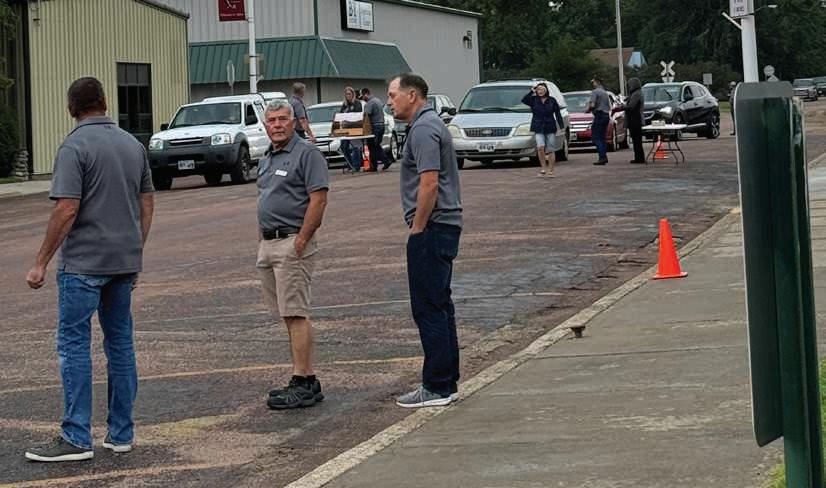


Board President Paul Voigt went live on Facebook to call the annual meeting to order at 5:30 pm.
At 7:30 pm, the business meeting continued live on Facebook with Secretary Dave Sternhagen verifying that a quorum was reached by exceeding 50 registered members. He also announced that the Official Notice of Annual Meeting was certified by General Manager Stephanie Horst as it was mailed to the members on July 29, 2024 and was contained within the Cooperative Connections Newsmagazine.
The financial report and the minutes of the 2023 Annual Meeting were also published in the newsmagazine. The minutes of the previous meeting were approved by a vote of the members on the same ballot as the director election.
Attorney Sheila Woodward presided over the election of the directors.
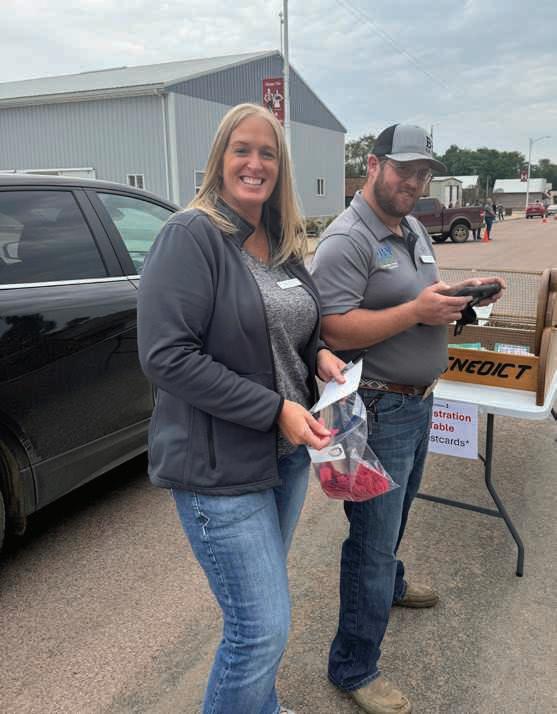
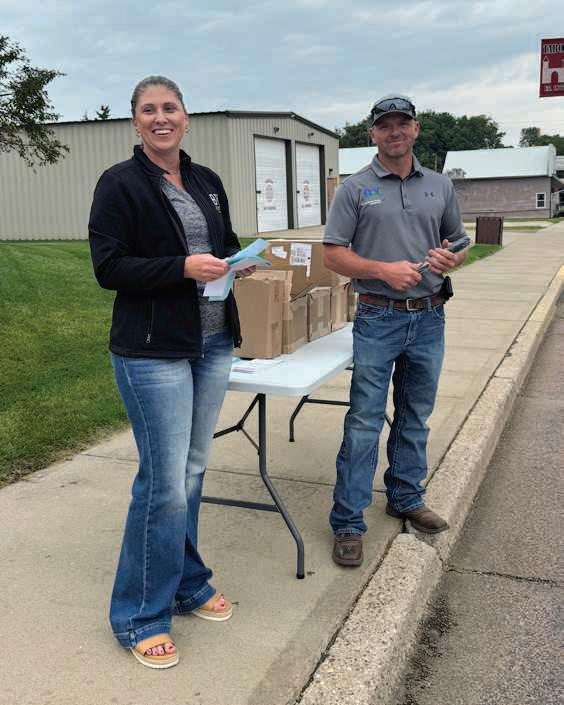
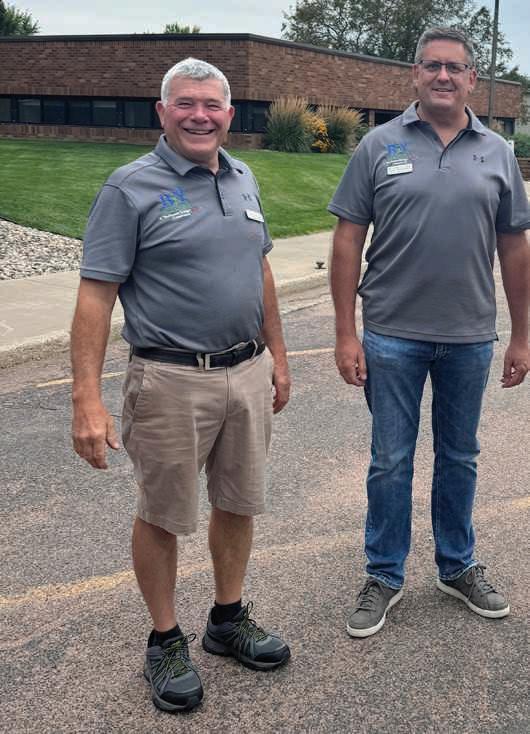
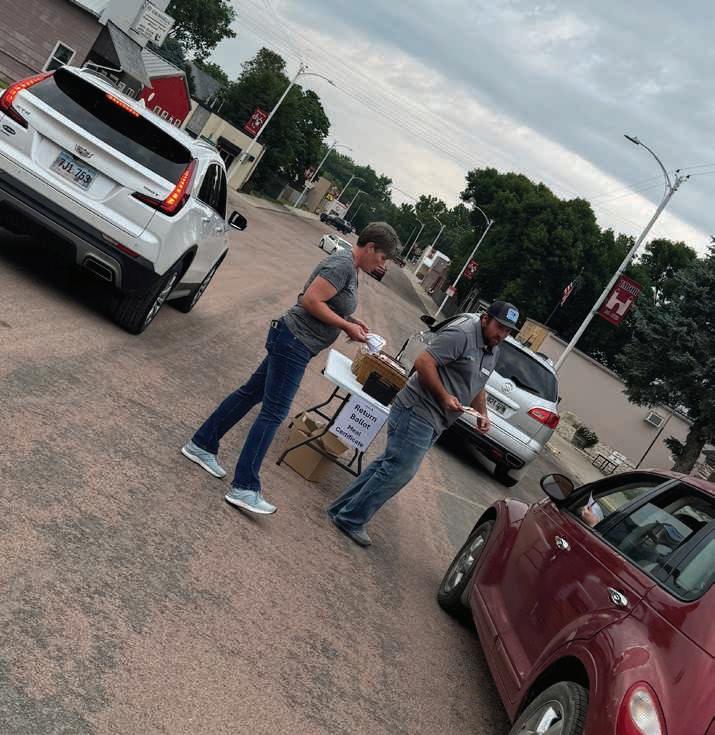
The election judges verified a valid election took place and tallied the votes to confirm that David Sykora, District 3 and Brian Brandt, District 5 were elected for a three year term.
Having no further business to conduct, President Voigt adjourned the business meeting and called upon Dean Sternhagen, and Robert Ruppelt to draw for the grand prizes.
You only needed to be registered but not present to win. The grand prize was five $100 bill credits.
David and Lynn Rous
Margo Mehrman
Brian and Dawn Vaith
Dennis and Kaycie Klimisch
Floyd and Julie Burbach
Congratulations to these members and we hope they enjoy seeing the credit on their electric bill.
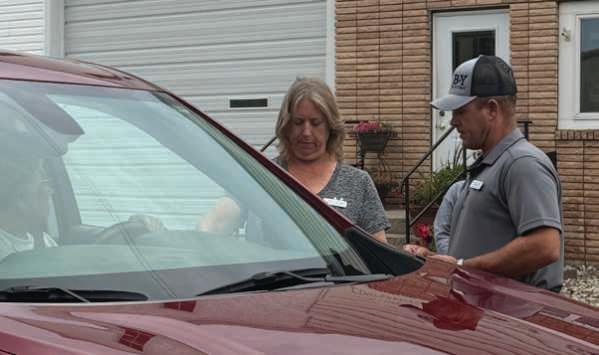
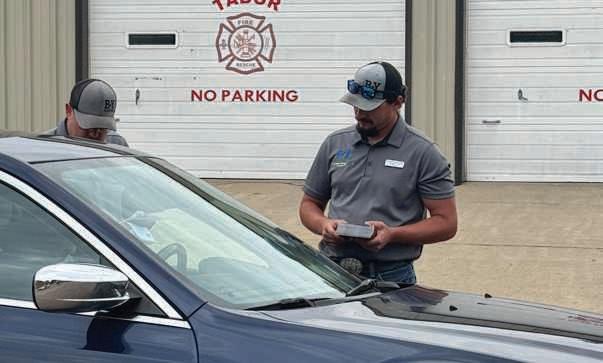
BOARD REORGANIZATION AND NEW DIRECTOR
President Dean Sternhagen
Vice-President Dave Sykora
Secretary Dave Sternhagen
Treasurer Robert Ruppelt
A thank you to John Lillevold for his time served on the Bon Homme Yankton Electric Cooperative board and a welcome to new Director for District 5, Brian Brandt.
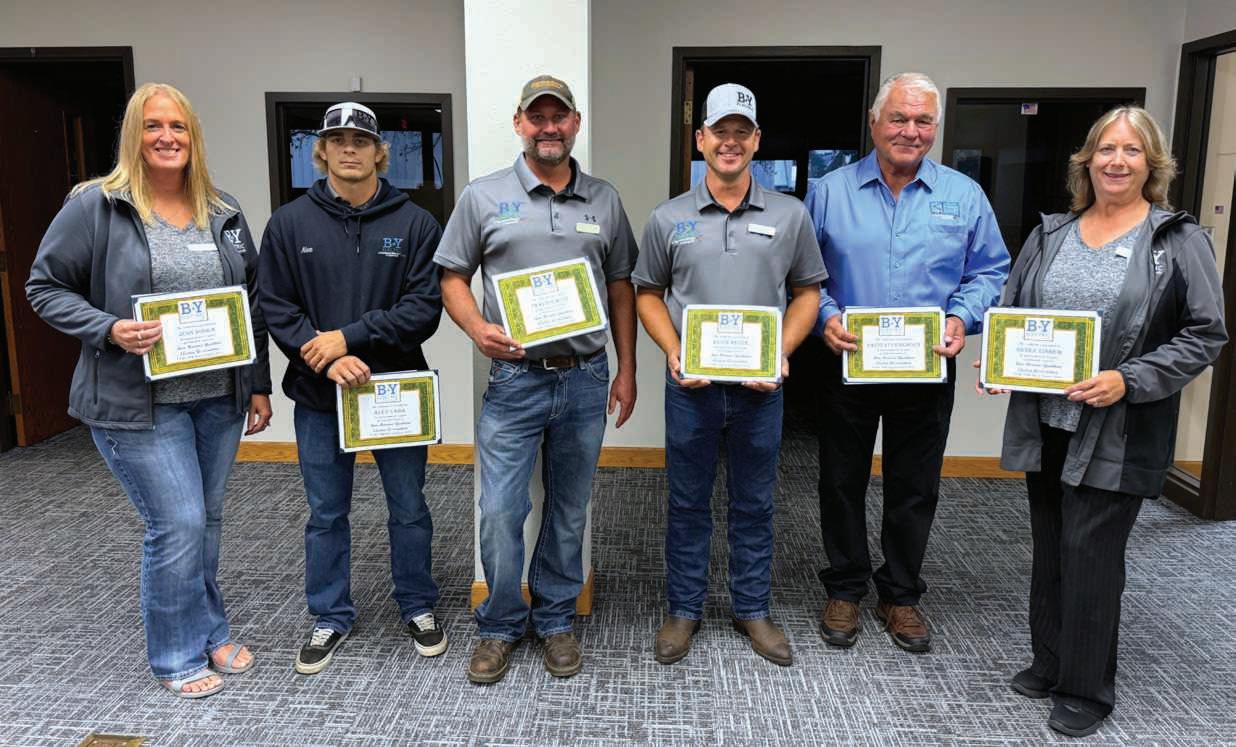

Several employees and one director were recognized for their hard work and dedication while reaching a new milestone in years of service.
(left to right) Billing Clerk Jenn Boska, 5 years; Lineman Alex Caba, 5 years; Lineman Travis Gause, 20 years; Electrician Kevin Meyer, 25 years; Director Dave Sternhagen, 35 years; Office Manager Nicole Einrem, 35 years.
Jacob Boyko jacob.boyko@sdrea.coop
Scattered across open fields and through narrow mountain gulches, a careful eye can spot many of South Dakota’s nearly 250 long-lost prairie villages and prospecting towns.
Many of these communities were once thriving outposts, railroad hubs, farming villages and mining towns, but were dealt their final blows by the hardships of the dust bowl, changes to railroad systems and the depletion of natural resources.
Most of the towns are long forgotten, their existence marked only by the rotted shell of an old wood barn or a crumbling foundation poking up from the ground.
Thanks to the work of local historical societies who have pieced together the history of the communities’ “booms and busts” through old newspaper clippings, plat maps and land records, we can get a glimpse into the lives of the first rural South Dakotans and learn about the communities that once bustled with life.
Unique among a cavalcade of abandoned Black Hills gold-rush towns, Galena’s roots are in its silver. The town was settled in the late 1870s after prospectors Patrick Donegan and John F. Cochran discovered layers of lead and silver ore near Bear Butte Creek while searching for gold deposits.
The U.S. government removed the two men from the area in accordance with Native American treaties. However,
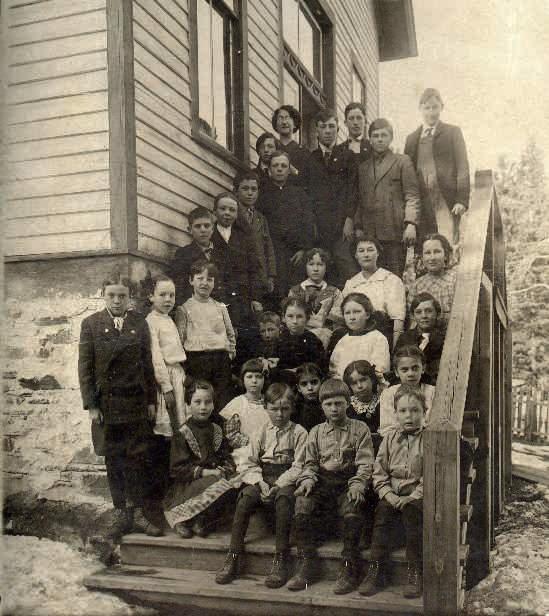
their exile turned out to be short-lived. Donegan and Cochran returned shortly after to mine their claim as more and more gold-hungry settlers tested the increasingly unenforceable treaties.
The claim, which would later become the Sitting Bull mine, turned out to be a mother lode, according to Galena Historical Society member Jeff Jacobsen.
Over the next several years, other mining operations popped up in the gulch as the miners’ families made Galena their new home. The town soon had multiple houses, a hotel, restaurant, stores, a catholic church, cemetery and school, attracting new settlers through its peak between 1881 and 1883.
Arriving from Chicago in hopes of expanding his fortune, Col. John Davey soon became a Galena mining heavyweight, buying up claims along the Bear Butte Creek, including the Sitting Bull claim.
Davey’s more than 125-man operation was running smoothly until trouble arose from a claim dispute. The owners of the nearby Richmond claim suspected Davey was digging too far into the hill and mining their silver. Davey claimed he was following the path of the ore, which according to mining law, he was allowed to follow onto another claim. The Richmond claim owners said the law didn’t apply to a horizontal blanket formation of ore, like the one in Galena.
A lengthy court battle ensued, and the judge shut down the Sitting Bull mine
until the ruling. Galena was suspended in controversy as many of the townsfolk found themselves out of work.
Thus began Galena’s rocky “boom and bust” cycle, Jacobsen explained.
“The boom time was when Col. Davey and other mines were producing, and then the lawsuit shut that down and you have a bust,” he said.
The judge ruled against Davey, and the operation never recovered. Galena would never again be the bustling town it was in the early 1880s.
“In 1892, some more people came into town and tried to start up again, so that was a boom, and then they went bankrupt, so there’s a bust,” Jacobsen continued. “There’s like three or four cycles like that in Galena.”
By the mid 1930s, the town had seen its final bust. The mining wasn’t comparable to the riches of the past, and interest in the gulch slowly started to fade. The tracks were removed and the school house closed in 1943.
Today, Galena is the best-preserved Ghost Town in South Dakota. On the second Saturday of each June, visitors can tour the town, visit the maintained graveyard and go inside the newly-restored schoolhouse, courtesy of the Galena Historical Society.
“It just kind of stands out,” Jacobsen said. “Galena is just one of the very few silver mining areas in the Black Hills when almost everyone else was trying for gold.”
In 1947, Deadwood resident Ollie Wiswell came across an orphaned coyote pup while he was out on a hike. He gave the pup, named Tootsie, to Fred and Esther Borsch of Galena. Tootsie gained fame as the mascot for the Borschs’ Deadwood liquor store, famously appearing on the store’s sign. Fred taught Tootsie to howl along to his singing, and the two recorded the album “South Dakota Tootsie.”
Tootsie, at this point a South Dakota mascot, rode through parades, was featured in an airline advertising campaign, and even embarked on a nationwide tour where she visited the White House and performed for President Dwight D. Eisenhower and Vice President Richard Nixon.
Gov. George Mickelson, a fan of Tootsie himself, signed legislation in 1949 making the coyote the state’s official animal. Tootsie died in 1959 and is buried near her home in Galena.
About nine miles northwest of Howard, just off state Highway 25, lay the remains of the ill-fated farming community, Argonne.
Marked by a blue historical sign, travelers-by can catch a glimpse of the town’s massive cement bank vault with its swinging iron door, an old silo bearing the town’s name, several concrete foundations, and a house falling into its own footprint.
The town’s founder, Dr. Louis Gotthelf, was a Prussian-born physician who emigrated to the United States in the aftermath of the Prussian revolution. Gotthelf staked his claim in 1881 and established the townsite in 1886.
The town was originally called St. Mary’s, named after Gotthelf’s daughter, and was strategically positioned along the Chicago and North Western railroad, with the streets running parallel to the railroad rather than the traditional east-west layout. Confusion with another St. Mary’s led to the residents voting to change the name to Argonne in 1920, which was chosen to honor local soldiers who had served in the Meuse-Argonne Offensive during World War I.
Despite having what should have been a prime location, Argonne failed to grow to Gotthelf’s satisfaction, and he left with his family for Parker in 1889.
A 1919 land boom in South Dakota finally turned things around for Argonne, Miner County Historical Society member George Justice Forster said.
“Most of the growth that happened initially was when it kind of took off as a
trade center,” he explained. “Suddenly the town had a railway depot, lumberyard, farmer’s cooperative and general store.”
In the early 20s, Argonne’s population boomed to about 100 residents, and the town offered new amenities including a school, blacksmith and post office.
Argonne’s peak was short-lived, and by 1930 the population had fallen to about 65 residents.
When Doug Jerlow moved to town in 1953, much of what was built in the town’s prime was left abandoned, and most of the businesses that did remain were struggling.
“It was past the peak,” Jerlow recounted. “One general store closed when the post office inside it closed, and that was an elderly lady who ran that and lived in a house by herself. The Haxby family’s store was open for maybe a year or two after that.”
Though the town was facing a bleak outlook, there remained one huge point of pride for Argonne: high school basketball.
Delbert Gillam, also known as the
Argonne Ace, led the Argonne Arrows to a 10-1 start in his junior year in 1953. Gillam also broke the state record for the most points scored by a player in a single game, making 31 field goals and 10 free throws, scoring 72. Argonne still holds this record.
The high school closed in 1956, but the community limped on for a few more years before the grade school closed in 1970 when the railroad picked up and left.
Doug Jerlow’s family, the last residents of Argonne, left town that same year.
Jerlow pointed out that while many other communities along the rail line like Unityville, Canova, Carthage, and Esmond struggled to recover from the abandonment of the line, for Argonne, it was the death blow.
Now, Forster and other members of the Miner County Historical Society are working to preserve the history of Argonne.
A historical marker will soon be placed east of Argonne on state Highway 25 that will tell the story of Argonne from its founding to its final household.
Though Jerlow now lives near Madison, he still farms near Argonne and owns most of the former townsite. As the unofficial mayor of Argonne, as Jerlow sometimes calls himself, he wants to keep the memory of his childhood hometown alive.
“It was just a nice community to grow up in,” he said. “Those small communities, I think it’s becoming harder to find them anymore.”
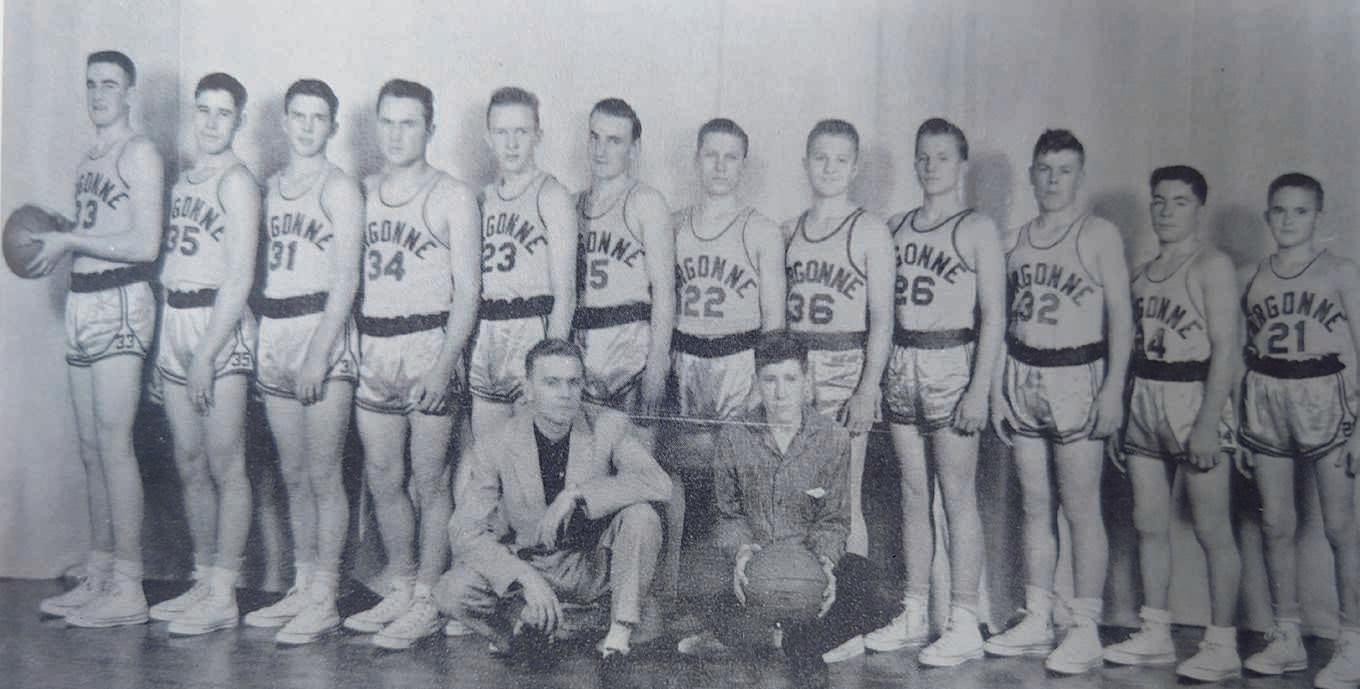

Jocelyn Johnson jocelyn.johnson@sdrea.coop
The energy future outlined by the U.S. Environmental Protection Agency’s Power Plant Rule means more blackouts, greater uncertainty and higher electric bills. This is the concern of electric cooperatives and other industry leaders who are in litigation with the EPA over the legality of the power plant rule issued in May of this year.
“The administration and the EPA specifically have made it a priority to undertake a ‘death by a thousand cuts’ approach to regulating the utility sector,” said Stephen Bell, National Rural Electric Cooperative Association’s vice president of advocacy, press and member communications. “They’ve enacted a number of rules, including the EPA Power Plant Rule. As a result, they’re proposing rules and regulations at a
rapid pace that have a direct impact on our industry specifically.”
Boiled down, the EPA’s Power Plant Rule requires coal-fired and natural gas power plants to capture 90% of carbon dioxide emissions using carbon capture and sequestration technology by 2032. This is not attainable according to NRECA who represents electric cooperatives nationally.
Alongside other industry leaders and 27 states’ attorneys general, NRECA filed a lawsuit and stay request in the D.C. Circuit against the EPA earlier this year. The stay request, which attempted to delay the implementation of the rule, was denied in July and an appeal was immediately made to the U.S. Supreme Court, arguing that
the Clean Air Act’s Section 111 requires EPA’s standards be based on technology that has been adequately demonstrated. A system that meets all of EPA’s requirements has never existed and therefore cannot be considered adequately demonstrated.
“No operating coal or natural gas power plants in America exist that use carbon capture at the scale that would comply with EPA’s regulation,” said Bell. “Their final rule is unreasonable, unrealistic and unachievable, because it relies on technology for implementing greenhouse gas reductions that just isn’t ready for prime time.”
Grid reliability is a concern for many in the energy industry – including local distribution cooperatives whose mission is to provide safe, affordable and reliable energy to member-consumers.
“The numbers don’t add up,” said Bell. “I think we are in a situation where reliability is being put at risk
by a policy that doesn’t focus on the importance of keeping the lights on.”
South Dakota Rural Electric Association’s General Manager Steve Barnett added the same sentiment, acknowledging that the timing of the power plant rule was troubling.
“At the same time the EPA is leading our nation down the path to fewer power plants, utilities are facing a surge in electricity demand – driven by the onshoring of manufacturing, the growth of the American economy and the rapid expansion of data centers to support artificial intelligence, e-commerce and cryptocurrency,” said Barnett.
Grid reliability affects everyone’s ability to turn on the lights, heat their homes and use electric appliances. However, the future of grid reliability does not have a positive outlook for many in the energy industry.
As it stands, the EPA’s rule would cause debilitating pressure on an already strained grid. It would also
have a potential impact on consumer costs.
“When demand is high and supply is low, costs go up,” Barnett said. “We’re concerned about threats to reliability as well as cost increases to our members.”
This growing demand – and shrinking supply – is why the North American Electric Reliability Corporation has warned that 19 states could see rolling blackouts over the next five years during times of high electrical usage, including during life-threatening cold snaps and heat waves.
“Demand for power is increasing and supply is not keeping up,” said Bell. “Against that backdrop, the EPA has proposed a rule that will force electric co-ops to take power plants offline. They will be forced to do more with less in a situation where we need more. This is not a recipe for success.”

SEPT. 14-OCT. 27
Mazing Acres Fall Festival
10 a.m. to 6 p.m. 30851 433rd Ave. Yankton, SD 605-760-2759

OCT. 4-5
Holman Acres Pumpkin Fest and Vendor Show Philip, SD 605-441-1060
OCT. 5-6
Run Crazy Horse Marathons Crazy Horse 605-390-6137 www.runcrazyhorse.com
OCT. 5-6
To have your event listed on this page, send complete information, including date, event, place and contact to your local electric cooperative. Include your name, address and daytime telephone number. Information must be submitted at least eight weeks prior to your event. Please call ahead to confirm date, time and location of event.
Magic Needlers Quilt Show Codington County Extension Complex Watertown, SD 605-881-3273
OCT. 4-5
25th Annual Pumpkin Fest Webster, SD https://webstersd.com/home
OCT. 5-6
Block Party Quilt Show
Oct. 5 starting at 9 a.m. Oct. 6 starting at 11 a.m. NFAA Easton Yankton Archery Center Yankton, SD 605-881-3273
OCT. 5-6
The Black Market Saturday 9 a.m.-5 p.m. Sunday 10 a.m.-3 p.m. W.H. Lyon Fairgrounds Expo Building Sioux Falls, SD 605-332-6004
OCT. 6
Giant Pumpkin Festival Bentley Memorial Building Bison, SD Enter Pumpkins by 11:30 a.m. 605-244-5475
OCT. 10-11
Rural Women in Agriculture Conference
Oct. 10 from 1-9 p.m. Oct. 11 from 7 a.m.-3 p.m. The Lodge of Deadwood Deadwood, SD SouthDakotaWomeninAg.com
OCT. 12
Springfield PTO Fall Festival 9 a.m.-2 p.m.
Springfield Elementary Gymnasium Springfield, SD 605-464-7379
OCT. 19
Buffalo County Fall Ball Live Music and Food
8 p.m. Fire Hall
Gann Valley, SD
OCT. 25-27
Forest of Fears Haunted Trail
7 p.m.-10 p.m.
Reclamation-Ranch 40787 259th St. Mitchell, SD
OCT. 26
Hill City Children’s Boo Bash and Pumpkin Festival Hill City, SD 605-574-2368
OCT. 26
Hartford Women of Today Fall Craft Fair
9 a.m.-3 p.m.
West Central Becker Center Hartford, SD 605-359-2049
OCT. 26
Owl-O-Ween
Noon-5 p.m.
Black Hills Raptor Center Caputa, SD 605-391-2511
OCT. 31
Treat Street
5:30 p.m.-7 p.m. Main St. Milbank, SD 605-432-6656
MilbankSD.com/Chamber
NOV. 2
Fall Fling Craft Show
10 a.m.-2 p.m.
Dakota Christian School Corsica, SD 605-366-7940
NOV. 2
Reliance Christmas Carousel
9 a.m.-3 p.m.
Legion Hall Reliance, SD 605-730-0553
Note: Please make sure to call ahead to verify the event is still being held.